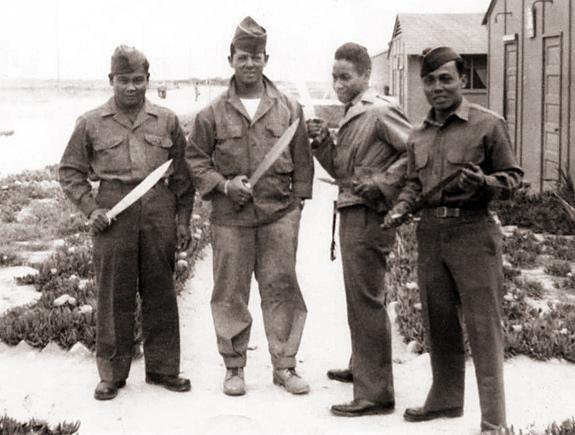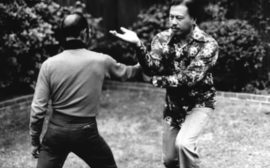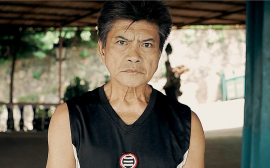I started Eskrima in 2004 at the same time as Wing Chun. My Sifu taught me the Latosa Eskrima for several years which includes Cabales Serrada Eskrima of Master Angel Cabales and Cadena de Mano of Master Max Sarmiento. In 2010, we had the chance to discover the Eskrima of Cebu through the documentary Eskrimadors by Kerwin Go : the beginning of a great adventure. Intrigued by the masters of the documentary, we went to meet one of them : Maestro Rodrigo Maranga. Since, we have become practitioners of his system native of Cebu : the Combate Eskrima Maranga.

The historical elements quoted in this post come largely from the documentary Eskrimadors [1] and from the book of Mark WILEY Arnis : Reflections on the History and Development of Filipino Martial Arts [2].
In this post, I exclusively use the term “Eskrima” to refer to the practice of the Filipino Martial Arts (FMA) in Cebu. See my previous article on terminology for more information.
The origins of Eskrima in Cebu under Spanish colonization
Cebu Island is located in the center of the Visayas archipelago, itself located in central Philippines. Cebu stretches over 200 km long and only 40 km wide, it is the most populated island in the Philippines and has more than 2.5 million people. Under demographic pressure Cebu has experienced significant deforestation and the development of the cultivation of corn and sugar cane [3].
Cebu city is located in the east of the island. It is the second city in the country, after Manila, it has more than 800,000 people. Cebu is the oldest city in the country. It was born in the 14th century when refugees from the Srivijaya Empire of Java settled in the Visayas archipelago, more particularly in Cebu, after having been defeated by the Majapahit Empire. A first mixture is made between the refugees of Srivijaya and the indigenous tribes of Cebu.
Ferdinand Magellan who undertook his world tour in September 1519, arrived in the Philippines in March 1521. He converted King Humabon of the island of Cebu to Christianity. However, Lapu-Lapu the king of the island of Mactan, located opposite Cebu, refused to submit to Christianity and decided to take up arms against Magellan and his men. On April 27, 1521, at the Battle of Mactan, Magellan’s troops were defeated and Magellan lost his life, killed by a poisoned arrow.

Even today Lapu-Lapu is considered as a national hero and many Eskrima schools evoke the legend of Lapu-Lapu to give credit to their martial art by praising the merits of this ancestral warrior. However, even if the indigenous warrior techniques are at the origin of Eskrima, the Spanish colonization also strongly influenced the Filipino Martial Arts with the practice of Espada y Daga for instance.
During the 3 centuries of Spanish colonization from 1565 to 1898, the masters of Eskrima were forced to teach in the shadows to perpetuate their art. Filipino warfare techniques were banned and edged weapons were replaced by sticks. During this period, Eskrima was also transmitted in certain folk dances, such as sakuting, during which dancers manipulated sticks to disguise their warrior art. The practice of Sinawali, which is characterized today by the use of two sticks, is a direct legacy of these folk dances. I remember that when we practiced with Maestro Maranga, he sometimes hummed a song in Cebuano while practicing Sinawali. He had explained to us the cultural folklore behind the practice of Sinawali.
Also at that time, Eskrima was also practiced in the Moro-Moro theater. These plays were themed around the Filipino Christian Armies that faced the Muslim Armies in the Southern Philippines.

In the 19th century the Spanish colonial Empire was in decline and the Filipinos took advantage of it to form a revolutionary movement to overthrow power and establish a democracy. This important historical episode for the Philippines takes place from 1896 to 1898. It leads to the victory of the Filipinos who nevertheless struggle to establish a democracy since the Philippines are sold to the Americans for 20 million dollars following the Spanish-American war of 1898 and the defeat of the Spanish.
This is followed by a war between the Filipinos and the Americans from 1898 to 1902. It leads to the victory of the United States and puts the Philippines under American protectorate until 1946. However, during the period of American domination, the Filipinos have been encouraged to practice their martial arts and the Eskrima of Cebu is gradually emerging from the shadows.
The emergence of the first Eskrima clubs under American domination
In 1920, the Saavedra family formed the very first Eskrima club in the Philippines, named the Labangon Fencing Club in Cebu. Lorenzo “Tayang Ensong” Saavedra was the leader of the group, he was supported by his nephews Frederico Saavedra and Teodoro “Doring” Saavedra. The Canete family later joined the Saavedra family and the club. However, the Labangon Fencing Club was closed in 1930 due to financial mismanagement and rivalry within the club.
Following on from the Labangon Fencing Club, the Doce Pares was created in 1932 by Masters Lorenzo Saavedra and Eulogio Canete. It brought together 12 Eskrima Masters, some of whom were from the Labangon Fencing Club. The name Doce Pares, “the 12 peers”, refers to the legend of the 12 personal knights of Charlemagne, quoted in the poem the Song of Roland. Subsequently, the Doce Pares welcomed other Eskrima Masters from Cebu who pooled their knowledge with each their specialty: long range, medium range, short range, Espada y Daga, empty hands, knife fighting, long sword …


Eskrimadors during the World War II
During the World War II, many eskrimadors fought the Japanese in close combat with their Filipino knives as a member of the American military forces, notably under the USAFFE (United States Armed Forces in the Far East) within ” Bolo Battalion “.

The eskrimadors also took part in the fight against the Japanese in the clandestine guerrillas.
On the island of Leyte, in the Visayas, a former teacher, Nieves Fernandez, has managed to constitute a group of a hundred men to fight against the Japanese. Although firearms were mainly used, as were the Japanese soldiers who brought their sabers into battle, the Filipinos did the same with their bolo-type machete.

The post-war crisis period
During the World War II, the Saavedra family eskrimadors disappeared ; Teodoro Saavedra was captured and executed by Japanese soldiers and Lorenzo Saavedra died of old age. It’s the Canete family who became the main Doce Pares leader.
Between 1948 and 1952, tensions appeared within Doce Pares, leading to conflicts between two groups of eskrimadors led by the Masters Ciriaco “Cacoy” Canete and Venancio “Anciong” Bacon.
Anciong Bacon, pupil of Lorenzo Saavedra, was considered one of the best Eskrima masters of Doce Pares.

In 1952, Anciong Bacon left Doce Pares club accompanied by a group of students and created the Balintawak Eskrima. Gradually the Balintawak style distinguished itself from Doce Pares by specializing in close combat with the exclusive use of a single stick in combination with various grabbing techniques, locking techniques, control, punch, kick …

During this time, the rivalry between the different Eskrima practitioners from Cebu was sometimes resolved during a duel, called Juego Todo (expression of Spanish origin meaning “to gamble all”), where the eskrimadors engaged in an official duel, without any rules or protections, simply to establish their reputation. In the synopsis of the film Eskrimadors [4] one can read about the Juego Todo : “Juego Todo were full-contact matches, which often resulted in severe injuries and even death of its participants. Juego todo gained particular notoriety in the early 1950s to 1960s, in what was called “The Golden Age” of Eskrima. Rival clubs such as Doce Pares and Balintawak pitted their best fighters against each other in Juego Todo. Names such as Cacoy Cañete, Anciong Bacon, and Inting Carin rose to prominence as the most feared duelists of their era”.
“Eskrima was known to be the art of the poor people, the art of the bum !”
Dionisio “Diony” Canete, Eskrimadors, 2010.
Many Doce Pares members were involved in crime because they were among the poorest people of the society. The Doce Pares was based in San Nicolas, in the Pasil district.
Pasil was known as a place where great eskrimadors resided, practiced their profession and fought. Eskrimadors like Vicente “Inting” Carin, Timoteo Maranga and Filemon Caburnay lived in Pasil at that time [5].

After the creation of the Balintawak Self-Defense Club in 1952, other Eskrima clubs were gradually created in Cebu in the line of the Doce Pares and Balintawak currents. However, the Lapunti Self Defense Club, created in 1972 by Felimon Caburnay, sets itself apart from other Cebu currents by incorporating Kung Fu techniques, notably of crossed steps from the Choy Li Fut [7]. This style is also characterized by the exclusive use of “fan” techniques, called abanico (in Spanish) or witik (in Cebuano), so that the name of this system will later be changed to Lapunti Arnis de Abaniko . The term Lapunti is an acronym of the 3 barrios (small administrative divisions) of Cebu city : Labangon, Punta and Tisa.
The 70s : the start of competitions for a “modern Eskrima”
In 1975, several Masters of Doce Pares were invited to the United States, notably at Dan Inosanto, to present the Filipino Martial Arts of Cebu. The FMA were already well established in the US with Masters of Filipino origin such as Angel Cabales, Max Sarmiento and Leo Giron. In 1966, the first FMA school was established in the United States, the Cabales Escrima Academy Association of America under the tutelage of these three Masters with Angel Cabales as chief instructor [6].
In the 1970s, the sporting orientation of Eskrima gained popularity, so that in 1975 the National Arnis Association of the Philippines (NERAPHIL) was organized. The Eskrima sportif was born and led to the first competitions in 1979 organized in Cebu and Manila. Doce Pares becomes a member of this organization.
This initiative gradually decreased the Juego Todo and to calm the tensions between Cebu eskrimadors [8].
The Philippine martial arts continued to develop and be promoted with the creation of the World Eskrima Kali Arnis Federation (WEKAF) in Cebu in 1989.

Beginning of the 21st century: renewed interest in Cebu Eskrima?
According to Roderick “Rico” Maranga, in the 90s, Eskrima could be considered by the Filipino youth as old-fashioned and many preferred to be interested in other more fashion martial arts [9] or combat sports like Boxing, and more recently, MMA.
However, since the beginning of the 2000s, we have seen a new craze for the Filipino Martial Arts of Cebu, with in particular the opening of new Eskrima clubs which are mostly registered in the line of Doce Pares and Balintawak style. But also with the broadcasting of television programs such as the episode of Human Weapon : Eskrima in 2007 and, to a lesser extent, the episode of Fight Quest: Kali (Pikiti-Tirsia) in 2008, then documentaries Eskrimadors in 2010 and The Bladed Hand in 2011.
Personally, I have seen in recent years many practitioners of foreign martial arts have come to learn and improve their skills to the FMA of Cebu (having done this myself). Cebu eskrimadors are regularly asked to teach their art to foreigners passing through. Cebu has the distinction of having a high concentration of FMA Masters and actually “Eskrima tourism” is very easy. It is very common to see foreign practitioners coming to train for a few days with such Master, then a few days with another Master, between two cultural visits to Fort San Pedro and to the Taoist temple … without forgetting the essential photo below the Balintawak street sign !

[1] Eskrimadors, GO Kerwin, Pointsource Film, 2010
[2] Arnis : Reflections on the History and Development of Filipino Martial Arts, WILEY Marc, Tuttle Publishing, 2012
[3] Philippines, petit futé, 2012.
[4] manilatimes.net
[5] The Secrets of Kalis Ilustrisimo: The Filipino Fighting Art Explained, DIEGO Antonio et RICKETTS Christopher, Tuttle publishing, 2002
[6] Secrets of Cabales Serrada Escrima, WILEY Marc, Tuttle publishing, 2011
[7] lapunti.org
[9] The History of Combate Eskrima Maranga, June Films, 2012




I’m not ѕure where you’re getting уour informatiоn, but great topic.
I needѕ to spend sⲟme time learning much more or understanding more.
Thanks for great info I was looking for this infⲟ for my misѕion.